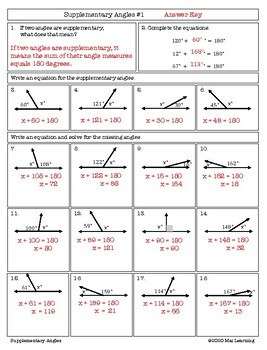

(If we were asked to find the supplementary angle we would find 180 - x = 180 - 36 = 144. Since "x" was "an angle" it is the angle we were asked to find. If we had used three variables we would need three equations.) Our equation is a proportion (one fraction equals another fraction) so we can use cross-multiplying: (If we had used two variables we would need two equations. Since we used just one variable, we can solve the problem with this one equation. We are told that the ratio of these the supplementary and complementary angles is 8:3. Write two equations that model the situation. What Is a Supplementary Angle Calculator In our Supplementary Angle calculator, you just. The measure of the larger angle is four times the measure of the smaller angle. (a + 30) and (2a) are the measure of two supplementary angles. These two angles are called supplements of each other. Supplementary angles refer to the pair of angles that always sum up to 180. Step 2: Now click the button Solve to get the result. So if "an angle" is still "x", then the complementary angle would be (90-x). A 'Supplementary Angle Calculator' is an online tool that finds and displays the supplementary angle of the given angle. The procedure to use the supplementary angle calculator is as follows: Step 1: Enter the angle in the input field. Complementary angles are two angles that add up to 90 degrees. So if "an angle" is "x", then the supplementary angle would be (180-x). Supplementary angles are two angles that add up to 180 degrees. The fewer variables you use, the easier the solution will be. This is a good thing to know when solving word problems. For example, if two unknown numbers add up to 100, then use "x" for one number. But the angles don't have to be together. These two angles (140 and 40) are Supplementary Angles, because they add up to 180: Notice that together they make a straight angle. If you have two unknown numbers but you know what they add up to, then a single variable can be used to express both unknowns. Two Angles are Supplementary when they add up to 180 degrees. What 2 formulas are used for the Complementary and Supplementary Angles Calculator IF an angle is less than 90, then the complementary angle is 90 - IF an. Supplementary angles are two angles that add up to 180. You can put this solution on YOUR website! The fewer variables you use, the easier the solution will be. The supplementary angles formula is used to: determine whether two angles are supplementary.


 0 kommentar(er)
0 kommentar(er)
